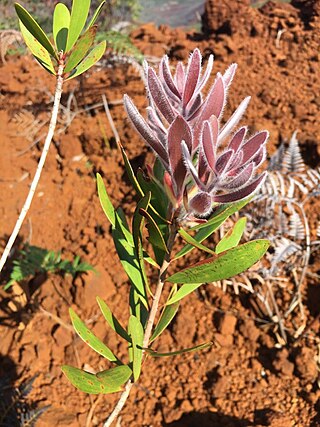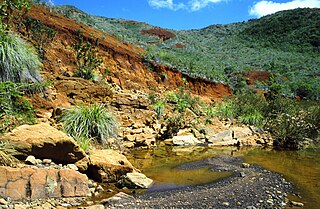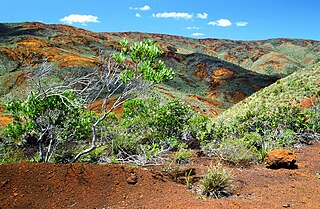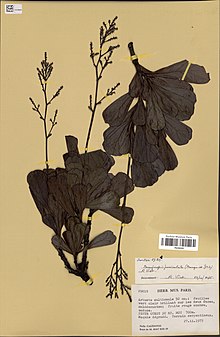
New Caledonia is a sui generis collectivity of overseas France in the southwest Pacific Ocean, south of Vanuatu, about 1,210 km (750 mi) east of Australia, and 17,000 km (11,000 mi) from Metropolitan France. The archipelago, part of the Melanesia subregion, includes the main island of Grande Terre, the Loyalty Islands, the Chesterfield Islands, the Belep archipelago, the Isle of Pines, and a few remote islets. The Chesterfield Islands are in the Coral Sea. French people, especially locals, call Grande Terre "Le Caillou".

The geography of New Caledonia (Nouvelle-Calédonie), an overseas collectivity of France located in the subregion of Melanesia, makes the continental island group unique in the southwest Pacific. Among other things, the island chain has played a role in preserving unique biological lineages from the Mesozoic. It served as a waystation in the expansion of the predecessors of the Polynesians, the Lapita culture. Under the Free French it was a vital naval base for Allied Forces during the War in the Pacific.

Garnierite is a general name for a green nickel ore which is found in pockets and veins within weathered and serpentinized ultramafic rocks. It forms by lateritic weathering of ultramafic rocks and occurs in many nickel laterite deposits in the world. It is an important nickel ore, having a large weight percent NiO. As garnierite is not a valid mineral name according to the Commission on New Minerals, Nomenclature and Classification (CNMNC), no definite composition or formula has been universally adopted. Some of the proposed compositions are all hydrous Ni-Mg silicates, a general name for the Ni-Mg hydrosilicates which usually occur as an intimate mixture and commonly includes two or more of the following minerals: serpentine, talc, sepiolite, smectite, or chlorite, and Ni-Mg silicates, with or without alumina, that have x-ray diffraction patterns typical of serpentine, talc, sepiolite, chlorite, vermiculite or some mixture of them all.

The biodiversity of New Caledonia is of exceptional biological and paleoecological interest. It is frequently referred to as a biodiversity hotspot. The country is a large South Pacific archipelago with a total land area of more than 18,000 square kilometres (6,900 sq mi). The terrain includes a variety of reefs, atolls, small islands, and a variety of topographical and edaphic regions on the largest island, all of which promote the development of unusually concentrated biodiversity. The region's climate is oceanic and tropical.

Ultramafic rocks are igneous and meta-igneous rocks with a very low silica content, generally >18% MgO, high FeO, low potassium, and are composed of usually greater than 90% mafic minerals. The Earth's mantle is composed of ultramafic rocks. Ultrabasic is a more inclusive term that includes igneous rocks with low silica content that may not be extremely enriched in Fe and Mg, such as carbonatites and ultrapotassic igneous rocks.

Serpentinite is a rock composed predominantly of one or more serpentine group minerals, the name originating from the similarity of the texture of the rock to that of the skin of a snake. Serpentinite has been called serpentine or serpentine rock, particularly in older geological texts and in wider cultural settings.

The New Caledonia rain forests are a terrestrial ecoregion, located in New Caledonia in the South Pacific. It is a tropical moist broadleaf forest ecoregion, part of the Australasian realm.

Serpentine soil is an uncommon soil type produced by weathered ultramafic rock such as peridotite and its metamorphic derivatives such as serpentinite. More precisely, serpentine soil contains minerals of the serpentine subgroup, especially antigorite, lizardite, and chrysotile or white asbestos, all of which are commonly found in ultramafic rocks. The term "serpentine" is commonly used to refer to both the soil type and the mineral group which forms its parent materials.
Lateritic nickel ore deposits are surficial, weathered rinds formed on ultramafic rocks. They account for 73% of the continental world nickel resources and will be in the future the dominant source for the mining of nickel.

Geissois is a genus of trees and shrubs in the plant family Cunoniaceae. It includes about 19 species mostly found in New Caledonia, but also in Fiji, Vanuatu, and the Solomon Islands. Leaves are opposite, palmate with 3-9 leaflets, with entire margin and intrapetiolar stipules. The inflorescences are simple racemes and bottle-brush like. The flowers have four red sepals, lacking petals, with many long red stamens. The fruit is a capsule, the seeds flat and winged. The genus includes several nickel hyperaccumulator and one aluminum hyperaccumulator, Geissois polyphylla.

Pancheria is a genus of shrubs and trees in the family Cunoniaceae. It is to endemic to New Caledonia and contains 27 species. Leaves or whorled, simple or pinnate. The flowers are arranged in capitula, fruits are follicular. The species are dioecious. The genus is well diversified on ultramafic rocks and some species are nickel hyperaccumulators. It is related to Cunonia and Pterophylla. It was named after Jean Armand Isidore Pancher.
Despite being a mineral rich country, Cameroon has only recently begun to investigate mining on an industrial scale. Strong metal and industrial mineral prices since 2003 have encouraged companies to develop mines here. The terrain mainly consists of granite-rich ground with areas of ultramafic rocks that are sources of cobalt and nickel. There are also deposits of bauxite, gold, iron ore, nepheline syenite, and rutile. Alluvial gold is mainly mined by artisanal miners.
Bulbophyllum keekee is a species of orchid in the genus Bulbophyllum, native to New Caledonia. It is protected in the northern province.

Melaleuca pancheri is a shrub or small tree in the myrtle family, Myrtaceae and is endemic to the south of Grande Terre, the main island of New Caledonia. It is one of only a few members of its genus to occur outside Australia and was formerly known as Callistemon pancheri Brongn. & Gris.

Laterite is a soil type rich in iron and aluminium and is commonly considered to have formed in hot and wet tropical areas. Nearly all laterites are of rusty-red coloration, because of high iron oxide content. They develop by intensive and prolonged weathering of the underlying parent rock, usually when there are conditions of high temperatures and heavy rainfall with alternate wet and dry periods. The process of formation is called laterization. Tropical weathering is a prolonged process of chemical weathering which produces a wide variety in the thickness, grade, chemistry and ore mineralogy of the resulting soils. The majority of the land area containing laterites is between the tropics of Cancer and Capricorn.

Nickel mining in New Caledonia is a major sector of the New Caledonian economy. The island contains about 7.1 million tonnes of nickel reserves, about 10% of the world's total. With an annual production of 200,000 tonnes in 2020, New Caledonia was the world's fourth largest producer after Indonesia (760,000), Philippines (320,000), and Russia (280,000), followed by Australia (170,000) and Canada (150,000).
Melaleuca brevisepala is a shrub in the myrtle family, Myrtaceae and is endemic to the north-west of Grande Terre, the main island of New Caledonia where it is known from only a few locations. It is one of only a few members of its genus to occur outside Australia.

Pycnandra acuminata is a species of plant in the family of Sapotaceae. It is a rainforest shrub, endemic to New Caledonia, and is adapted to the nickel-rich ultramafic soils found there. Pycnandra acuminata is notable as one of the most prolific hyperaccumulators of trace metals known, actively absorbing nickel from the soil and concentrating it within the plant to a concentration of up to 25% nickel citrate as dry weight of the sap, which is turquoise-green in colour due to the nickel content. the only known plant with turquoise sap. An excellent photo can be seen at. The vernacular name in French is sève bleue.

Mining maquis is a type of shrubland biome. It forms on ultramafic rock as a result of forest cover retreat due to repeated wildfires. It is common on New Caledonia.
Wittsteinia balansae is a species of shrub in the Alseuosmiaceae family. It is endemic to New Caledonia. It was originally described in its own genus Periomphale.















